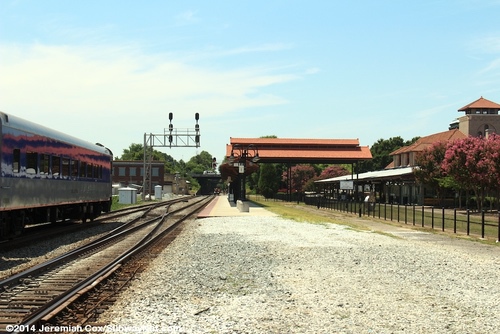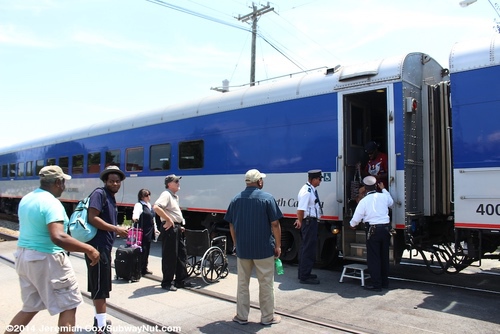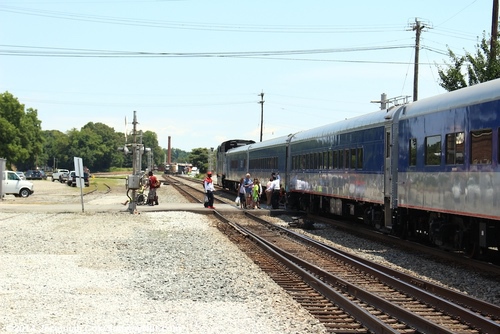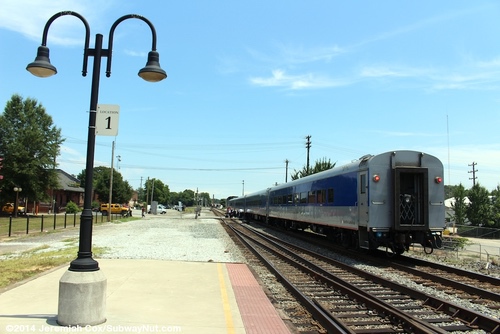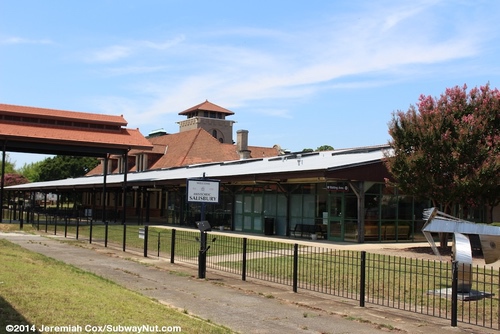

 Charlotte, NC Charlotte, NC | Crescent | High Point, NC  |
 Kannapolis, NC Kannapolis, NC | Carolinian | |
| Piedmont |
Salisbury has seen continuous service although the Southern Railway provided passenger service until 1979 when it finally decided to join Amtrak after originally resisting. Part of the requirements for railroads whom decided not to join Amtrak required them to operate all passenger service operating in 1970 for a period of 5 years. This meant Salisbury remained a transfer point until 1975. Passengers could transfer from the daily Piedmont — a completely different day train than today’s Piedmont running between Atlanta and Washington, DC) — to Trains no. 3 and 4, that ran triweekly up the branch line into the mountains to Asheville, making 13 intermediate stops that were all flag stops. In 1979 just before Amtrak took over service cuts reduced Salisbury trains to one a day, only the Southern Crescent that still stops in the middle of the night. On May 12, 1990 daytime service to New York was restored, on a different route than the Crescent on the Carolinian via Raleigh and Richmond. A new second train, also named the Peidmont but running only between Charlotte and Raleigh began in 1995 with today’s third midday round-trip beginning in 2009.
The historic Salisbury Station was designed by architect Frank Milburn in the Spanish Mission style and opened in 1908. The station is made of grey bricks with a Spanish tile roof that isn’t at all flat. Most of the windows are arched. The main waiting room when approached from the street has a central light filled tower with that contained the former ticket office. The roofline attaches to separate single-story low profile buildings north of it that were originally for freight and railway express. The station was abandoned by the 1980s. The large station was purchased by the Historic Salisbury Foundation in 1985 to begin restoring the building and making it mixed-use. The original great hall waiting area reopened as an event space in 1993. In 1990 and 1996 phases opened new office space in the various former railroad office and freight buildings around the station. Passenger trains were relegated to a small waiting area at the northern end of the station that is staffed by a NC Station Attendant. A new, modern 600 foot ADA platform that is access controlled by the station attendant with a gate opened between 2005 and 2010 replacing an original simple strip of pavement.
For boarding passengers, the modern platform is a low-level side platform that is fully fenced off on the westernmost track of the two-track line. It nearly begins at the grade-crossing of Council Street (SW end) but a large hump of ballast tries to keep passengers from entering here. It ends 150 feet short of the grade-crossing of Kerr Street. This makes the fencing and gate to the platform seem a bit silly. A canopy covers the middle 300 feet of the platform. Black columns hold up the brown framework of the canopy that has a Spanish tiles roof in the style of the original station. In the middle a covered walkway leads the 50 feet across where additional siding tracks once were and under the large canopy structure outside the historic station. The entrance to this walkway has a manually controlled gate that the NC Station attendant opens and closes.
Heading out from the platform exit, passengers reach a wide area outside the station buildings that is covered by a large metal canopy structure that extends out from the station roof and originally covered the main platform area. It seems like it was a similar multiple platform design with covered platforms that still exists in Portland, Oregon’s Union Station with a covered pedestrian crossing to a second covered platform. A small outdoor corridor through arches leads directly to Depot Street. This outdoor corridor divides the former grand passenger depot from the freight and railway express buildings. Unfortunately the grand passenger waiting room has been nicely restored but is now just a special event space and is not open to the general public. On a wall outside, a replica Southern Railway Train bulletin lists the 8 round-trips per day that to and from Washington that stopped at the station along with the branch lines Norwood (3 trains) and Asheville (2 trains).
Signs direct passengers to small Amtrak waiting area that is along the former freight area turned offices and is at the northern end of the depot. The waiting area has storefront window walls built beneath the end of the wide canopy in this area. A number of late 1990s signs with the pointless area direct passengers to the waiting room. Streetside is a grey pointless arrow sign that is hard to spot. The waiting area itself is perfectly adequate with plenty of light, a couple benches, restrooms, along with a snack, and soda machine. There is a small office for the NC Station attendant, a Quik-Trak machine and NC Amtrak schedule behind the attendant’s desk.
Just south of the station, across Council Street is a small Park and Ride lot with a couple of bus shelters. Here City of Salisbury Local buses can connect passengers to the North Carolina Transportation Museum in Spencer on weekdays (I planned this trip before realizing that this museum is accessible by public transportation). Regional Rowen Transit System minibuses run to Kannapolis pretty much following the railway line with stops in two intermediate towns not served by Amtrak.
All Photos: 17 July, 2014
